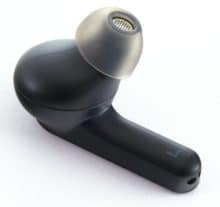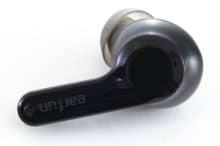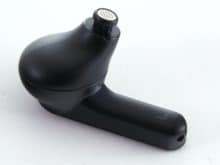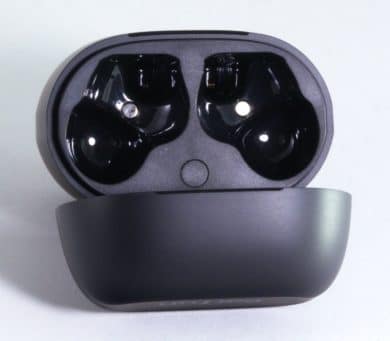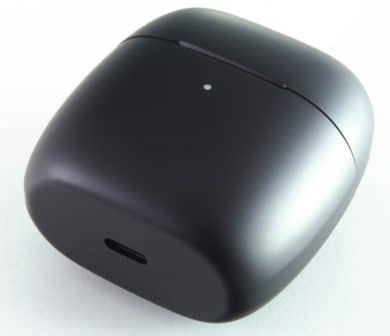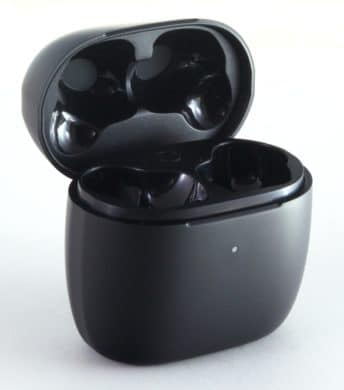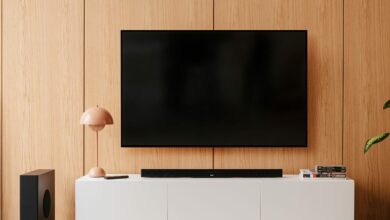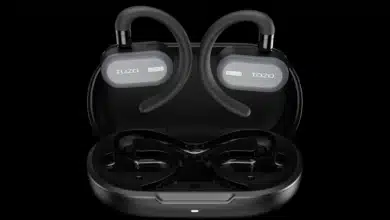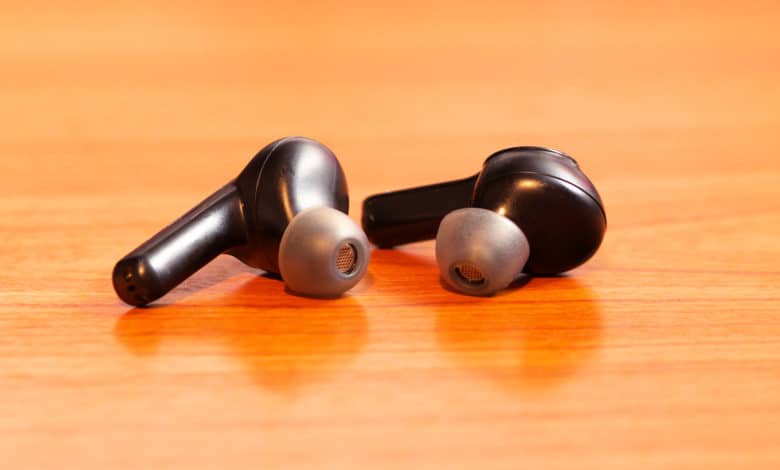
They were announced at CES 2020, and after some delays they are now finally available: The Air TWS Earbuds from Earfun. These are completely wireless in-ear headphones that rely on pure touch operation. In addition, Earfun promotes the headphones with an ear recognition feature to pause songs automatically, and with an IPX7 certification that allows for temporary submersion.
How the Earfun Air TWS Earbuds perform in practice for their price of around 50 euros (currently: € 50.99 *), and how well the advertised features work, will be clarified in the following test.
Technical details (manufacturer information)
| Connection type | Bluetooth 5.0, single operation possible |
| Battery life | 7h headphones + 28h charging case |
| Capacity | 55 mAh headphones + 500 mAh charging case |
| Dimensions (loading case) | 53.3 x 52 x 34 mm |
| Weight | 51 g |
| Protection class | IPX7 |
| Special features | touch operation, ear recognition |
Scope of delivery
In addition to the headphones themselves, Earfun supplies a total of four sets of silicone caps. Furthermore, a charging case made of black plastic as well as a 50 cm long USB-C cable and a manual are included.
Design & workmanship
The design of the Air headphones is similar to that of many in-ears: the driver sits directly on the ear in a flattened-round case. The sound is conducted directly into the ear canal via a taper, and the respective silicone caps are applied to this taper.
Earfun uses black plastic for almost all in-ears, while the grille in front of the drivers and the two contacts on the underside are made of metal. In addition, not the entire case is matt: the entire exterior is made of slightly shiny plastic. This surface is also used for touch operation, which is integrated in both receivers. The status LED is also located on the top of the outside.
The same combination of materials is also used in the case supplied: This is also mainly made of matt black plastic, but the headphone bezel is in high gloss. The charging status LED of the charging case is a little underneath the opening flap, the case is charged over a USB-C port at the bottom.
We can’t complain about the workmanship of the headphones and the charging case: Both are very stable and have no optical conspicuities – even the gap dimensions fit. The plastic is also pleasant to the touch.
We can confirm the IPX7 certification promoted by Earfun: The headphones still work without problems even after a short immersion. This means that they can be used without any problems, for example in heavy rain – even if the touchpad as a (reliable) operating option should then be omitted.
Operation, wearing comfort & battery life
The Air headphones are operated entirely via the touch surfaces on the outside, there are no mechanical buttons on them. They are switched on and off by opening and closing the charging case, which also has a single button to reconnect the headphones or to reset them to their factory settings.
The touch operation of the headphones is very intuitive: if you touch the left/right side longer, the volume is lowered/increased. Pausing is done with a “double click” and the next track can be played by tapping three times. Unfortunately, the touch control is not always reliable in practice: From time to time, pausing and advancing are confused, and there is no acoustic feedback. This isn’t overly dramatic, as the error can be quickly corrected by retyping, but at least a (different) beep as feedback would have been nice. Without this you always have to wait and listen, whether you have paused the song or whether the next song just starts very quietly or even with a time delay.
The ear recognition works very reliably, even if this term is a bit pompous: it is simply a proximity sensor that is built into both listeners and pauses the playback as soon as nothing is in the immediate vicinity. This is a very useful feature.
Unfortunately, the Air headphones could not keep the battery life promised by Earfun in our test: We promised 7 hours per charge and four full charges through the charging case. In practice, however, the Air headphones only reached five and a half hours in our test at a typical volume for use with background noise.
Then we were able to charge the headphones with the charging case exactly three times and each time we could reach five and a half hours of operation again. Afterwards, both the battery in the charging case and the one in the headphones were exhausted: a further charging resulted in only a few minutes of operation time. Thus, the combination of speaker and case has a total battery life of 22 hours, which we still rate as good.
Finally, the wearing comfort remains, and the Earfun Air can also convince here: inserting it is easy and the headphones still fit comfortably even after a long time. They also stay in the ear very well: “We never had any problems with the Earfun Air during sports. The silicone tips are very firmly attached to the earpieces so that they cannot come off by themselves, even with rapid movements.
Recording and playback quality
In terms of reproduction quality, the Earfun Air delivers a decent result, but does not set new standards. The detail in the mid and high frequency range is good and there is also a certain amount of bass. Unfortunately, the in-ears are not good enough for really low frequencies; there is still some room for improvement here. In addition, the sound tends to blur a bit from time to time. The sound quality is therefore still more than suitable for everyday use, but we wouldn’t recommend the Air headphones for the detail-loving music enjoyment.
Earfun also delivers a solid picture in terms of recording quality: the voice is recorded in a clear and understandable way with acceptable background noise, even if background noise is a problem due to the design. A “studio sound quality” is by far not given, but for normal telephone use the Air headphones are good to use.
Conclusion
Earfun has succeeded in creating decent in-ears with the simply named Air headphones, which on the one hand want to convince with a modern package of functions, but without weakening the usual criteria of battery life and sound quality.
Indeed, the Air headphones stand out positively due to their touch operation as well as the ear recognition, even if there is still a slight potential for improvement in the former. The battery life is also convincing in combination with the charging case, and we can also confirm the advertised IPX7 certification.
The sound quality has to be sacrificed, because Earfun lags a bit behind the competition in this respect: the bass is a bit too little pronounced for us, and occasionally we miss details. Nevertheless, you can still hear music well with the headphones, and without a direct comparison, the difference shouldn’t be too noticeable.
For a price of around 50 Euros (current: € 50.99 *), we therefore consider the Earfun Air to be quite a successful in-ear, as long as the additional features are a must. If you can get something out of the flair of a touch control, then the headphones should be a good choice.
Earfun Air TWS Earbuds
Workmanship
Wearing comfort
Sound quality
Recording quality
Features
Value for money
79/100
Decent in-ears with many features but also points of criticism




